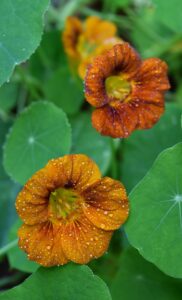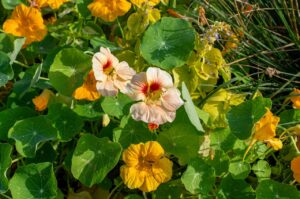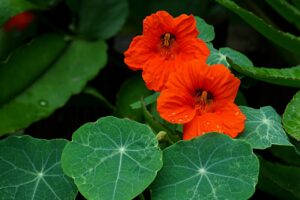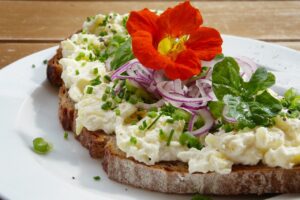Nasturtium Flowers are cheerful and easy-to-grow flowers. The Nasturtium flowers come in a variety of colors from orange, yellow, red, cream, salmon pink, and burgundy to crimson in color with trumpet-shaped flowers sometimes featuring stripes and bi-colors. Some cultivars of Nasturtium have attractively marbled or mottled leaves, too.
Nasturtium Plants have bold blooms and edible leaves, flowers, and seedpods making them especially fun flowers for kids to plant and a favorite companion plant in the garden.
The herbaceous Nasturtium flowers are native to South and Central America and are known for their rich, saturated, jewel-toned colors.
Nasturtiums (Tropaeolum) are one of the quickest and easiest annuals to grow. The most common Nasturtium cultivars which are grown are botanically called Tropaeolum majus. Nasturtium is a Latin word that means “nose-twister” or “nose-tweaker.” The name comes from how these plants’ peppery taste affects seasonal passageways when consumed.

These lovely plants, with their unique greenery and vibrant flowers, grow well in containers or as ground cover around vegetable gardens. Nasturtiums are grown as annual plants in most areas, though they may also grow as perennial plants in frost-free zones.
The alternating leaves are whole or palmately lobed, hairless, and peltate. The circular leaves have radiating veins and are a sort of dull green. The leaves and stems are fleshy.
Types and Cultivars of Nasturtium flowers
There are many varieties of nasturtiums, which are divided into two main types:
-
Trailing or Climbing Types
-
Bush Types
Their main difference is their growth habit, with trailing nasturtiums forming long vines and bush nasturtiums remaining more compact. (Bush types are also sometimes called “dwarf” nasturtiums.)
Bushy varieties look great in containers and hanging baskets or at the front of a border while climbing varieties can be trained up wigwams or obelisks and will twine through other plants. These can also be used as ground cover, spreading across gravel or cascading down a slope or bank. Both types grow very well in pots.
Some Nasturtium Cultivars to grow in Your Garden
‘Alaska’
‘Alaska’ has green and white variegated leaves which also look beautiful whether flowers are present or not. Alaska produces flowers in different colors from yellow, cherry, salmon, and crimson color single or a mix of shades. This cultivar gives the best performance while also tolerating partial shade.
‘Banana Split’
‘Banana Split’ has light cream blooms with crimson flecks in the center. Banana split nasturtium seeds can be planted in borders, pots, and other outdoor planting areas. ‘Empress of India’ “`

‘Empress of India’
‘Empress of India’ has dark green foliage with dark red colored flowers. This cultivar is ultimately the show-stopper in your garden. Because of their compact growth patterns, the cultivars maintain a clean appearance without the need for regular trimming. When grown alone, the elegant-looking Bushy ‘Empress of India’ plant attracts hummingbirds and butterflies.
‘Jewel Mix or series’
This variety grows profusely and at a height of 16 inches, and gives profuse flowers. ‘Jewel Mix’ produces yellow, orange, red, rose and mahogany flower colors.
‘Canary Creeper’
This trailing cultivar is best planted near fences or trellises. This unique specie has yellow blooms that stretch out like canary wings, giving it a distinct appearance from more typical types.

How to take Care of Your Nasturtium Flowers
Know about the Light Requirements of Nasturtium Flowers
Nasturtiums need full sunshine for at least half the day to grow well. Plant nasturtiums in full sun for about 6 to 8 hours of sunlight for the best result. They will also grow in partial shade in about 3 to 6 hours of sunlight, but won’t bloom as well.
Soil Requirements of Nasturtium Flowers
Nasturtium can tolerate a wide range of soil types. The plant can grow in rich or poor soil from clay to sandy soil. But Soil must be well-drained. Unlike many other flowers, Nasturtium does not mind any type of soil and even thrives on poor soils. If you grow Nasturtium flowers in rich soil you can get on more foliage, not the flowers.

Temperature and Humidity Requirements of Nasturtium Flower
Most of the cultivars are treated as annual flower means that they complete their life cycle in one growing season. Few cultivars of Nasturtium which are grown as perennial in USDA Hardiness zone 9-11. The nasturtium plant grows best at 70oF (21oC) Temperature and can also tolerate a light frost. The plant also prefers a moderate level of humidity. Although the plant is hardy but still can struggle in extremely humid or in dry conditions.
How to start a New Nasturtium flower?
Nasturtium seeds may be sown directly in the garden or started indoors. Their fragile roots are sensitive to transplanting, so we prefer to direct-sow them.
Start seeds indoors 2 to 4 weeks before your last spring frost date.
For outdoors sow seeds 1 to 2 weeks after your last spring frost date. Soil temperature should ideally be between 55oF and 65oF (12oC and 18oC). Plan to protect young seedlings from frost.
How to sow Nasturtium Flower Seeds
You can sow nasturtium seeds directly where they are to flower.
Rake the soil to a fine tilth and make sure it is free of weeds.
Sow the seeds 1.5cm deep, either push them in with your finger or use bamboo to make a shallow drill.
Sow the seeds about half an inch deep and 10 to 12 inches apart in the garden.
Cover the seeds with soil.
The Plant should appear in 7 to 10 days.
Once the seedlings emerge thin them to around 30 cm apart.
To plant in the ground dig a hole that is the same size as the pot your plant was growing in, and plant so that the crown of leaves is at soil level.
To plant in a pot mix two-thirds peat-free multipurpose compost with one-third fine gravel or grit, to reduce fertility and ensure good drainage.
Water Requirements of Nasturtium Flowers
Water regularly throughout the growing season, but be careful not to overwater your plants. Nasturtiums are somewhat drought tolerant, but still prefer to grow in moist soil. Plus, water-stressed plants will have subpar blooms and flavor. In summer, nasturtiums may stop blooming if they become heat-stressed. Keeping them sufficiently watered can help to mitigate the effects of extreme temperatures. Plants growing in the ground rarely need watering. Plants growing in containers should be watered to keep the compost evenly moist, but don’t feed them.
Fertilizer Requirements of Nasturtium Flowers
Nasturtiums do well in poorer soils and do not typically need extra fertilizer. Unless your soil is extremely poor. Add compost in the soil before planting is enough to provide nutrients to your new growing plant. If you did not add compost add a balanced amount of fertilizer that contains major nutrients. Too much nitrogen will encourage more foliage than flowers.
Deadheading
Deadheading is usually not necessary. But cutting off the faded/dead flowers will prolong blooming. If you’re growing nasturtium in containers, they may need to be trimmed back occasionally over the growing season. This encourages the plants to produce new foliage. You can also pull off ripe flowers for salads and placing them on top of summer desserts is always recommended.
Seed Harvesting
If you allow the seedpods to mature, you can save the nasturtium’s chick-pea-size seeds and replant them in the spring.
Let the seeds dry out on the vine; they’ll fall off. Collect them, brush off the soil, dry them, and store them in a paper envelope in a cool and dark place.
Interesting Facts about Nasturtium
Nasturtium flowers are said to symbolize patriotism.
Problems
Nasturtiums are likely to attract large and small white butterflies (known as cabbage white butterflies), and their caterpillars eat the leaves. You can pull the caterpillar off and squash them, or spray with a natural caterpillar killer.
Nasturtiums are also attractive to aphids, particularly blackflies who suck the sap, so spray with a garden insecticide to control them. Make sure to spray the underside of the leaves, too.
Some Interesting Uses of Nasturtium Flowers
Trailing nasturtiums are a good choice for growing in a window box or hanging basket, as their vines will drape and climb beautifully.
Bushy nasturtiums are a better choice for smaller gardens where space is limited, and for borders and edges.
It can be grown on trellises and fences, or in a frame within a garden bed.
These look especially nice when trailing down in a hanging basket.
Plant this flower in vegetable gardens especially planted alongside broccoli, cabbage, and cauliflower, where it keeps pests away.
An important feature of all nasturtiums is their edibility! Nasturtium’s leaves, flowers, and seedpods have a peppery, almost mustard-like taste, which makes them lovely as a garnish in salads. The seedpods may also be pickled and used like capers.

In fact, they are often used as a trap crop in companion planting, drawing aphids and other garden pests away from the more valuable vegetables.
Pests aren’t the only thing nasturtiums attract, however. They are also a favorite of pollinators like bees, butterflies, and hummingbirds, and their pretty fragrance makes them a good choice for cut-flower gardens, too.


